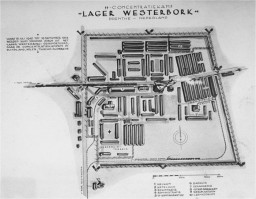You searched for: 数字货币游戏,加密货币游戏,数字币游戏,ust博彩游戏,【www.2266.com,复制打开网址】,unit泰达币博彩网站,区块链游戏排名,区块链游戏nft,区块链游戏平台,nft游戏有哪些,nft是什么游戏,以太坊游戏,区块链游戏赚钱网站,币圈游戏,区块链博彩平台,网址kaefhfkccdckbghcd
<< Previous | Displaying results 176-200 of 1751 for "数字货币游戏,加密货币游戏,数字币游戏,ust博彩游戏,【www.2266.com,复制打开网址】,unit泰达币博彩网站,区块链游戏排名,区块链游戏nft,区块链游戏平台,nft游戏有哪些,nft是什么游戏,以太坊游戏,区块链游戏赚钱网站,币圈游戏,区块链博彩平台,网址kaefhfkccdckbghcd" | Next >>
-
Hürtgen Forest
ArticleIn months of fighting with heavy losses, the US Army attempted to pierce the heavily fortified Hürtgen Forest section of Germany's border defenses. Learn more about the campaign.
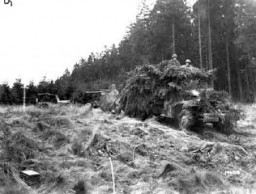
-
Henry Morgenthau, Jr., testifies in support of Lend-Lease
PhotoHenry Morgenthau, Jr., testifies before the Senate Foreign Relations Commission in support of the Lend-Lease bill to aid Britain. Morgenthau was secretary of the treasury under President Franklin D. Roosevelt. Lend-Lease was the name of the US policy of extending material aid to the Allies before and after the United States entered World War II.
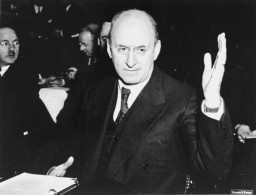
-
Aron and Lisa's firstborn child
PhotoAron and Lisa's firstborn child, Howard. Chicago, Illinois, 1949.
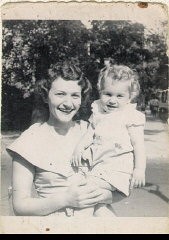
-
Family celebration
PhotoCelebration after one of Regina's sons, Harry, received the Eagle Scout Award. February 16, 1973.
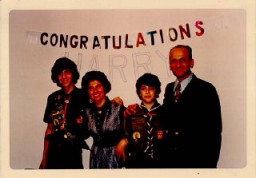
-
Riegner Cable
PhotoBritish Jewish leader Sidney Silverman forwarded to American Jewish leader Stephen Wise this copy of a cable originating from Gerhart Riegner, World Jewish Congress representative in Geneva. Riegner had sent through their respective governments two cables warning Silverman and Wise of Nazi plans to exterminate European Jewry. The US State Department delayed delivery of the cable from Riegner to Wise, who initially received this version. United States, August 29, 1942.
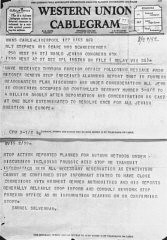
-
Encircling the Ruhr
ArticleEncircling the Ruhr region was a key Allied military goal. Learn about the military campaign to capture the industrial center of western Germany in the last months of WWII.
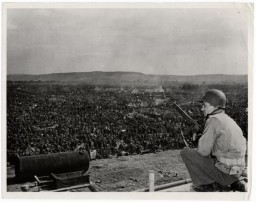
-
Evian Conference fails to aid refugees
FilmDelegates of 32 countries assembled at the Royal Hotel in Evian, France, from July 6 to 15, 1938, to discuss the problem of Jewish refugees. The refugees were desperate to flee Nazi persecution in Germany, but could not leave without having permission to settle in other countries. The Evian Conference resulted in almost no change in the immigration policies of most of the attending nations. The major powers--the United States, Great Britain, and France--opposed unrestricted immigration, making it clear…
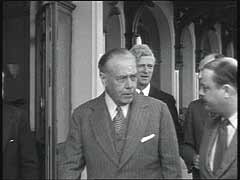
-
Insignia of the 30th Infantry Division.
PhotoInsignia of the 30th Infantry Division. The nickname of the 30th Division was Old Hickory, named after President Andrew Jackson.
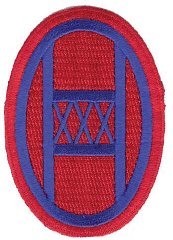
-
Wedding photograph
PhotoThis wedding photo of Blanka and her husband Harry appeared in an Oregon newspaper. Blanka has no other photo of their wedding. "The war taught me that things are not important," she says.
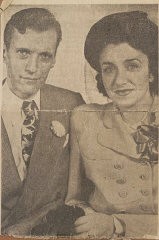
-
Aron and Lisa when they came to America
PhotoAron and Lisa when they came to America. Photograph probably taken in Chicago, Illinois, 1947.
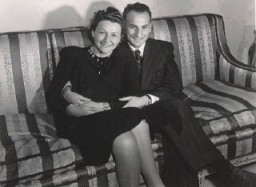
-
Aron and Lisa's three sons
PhotoAron and Lisa's three sons (Howard, Gordon, and Daniel) at the middle son's graduation from the University of Wisconsin. Madison, Wisconsin, ca. 1972.
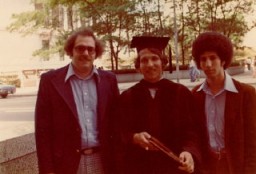
-
Cordell Hull signs neutrality proclamation
PhotoPortrait of Secretary of State Cordell Hull signing President Franklin D. Roosevelt's neutrality proclamation. September 5, 1939.
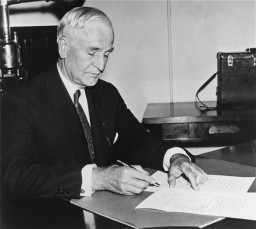
-
Town hall meeting at the Manzanar Relocation Center
PhotoJapanese Americans hold a town hall meeting at the Manzanar Relocation Center in California, 1943.
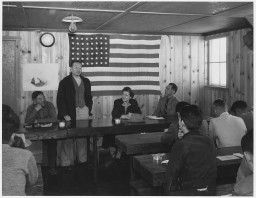
-
The Hadamar Trial
ArticleThe Hadamar Trial of October 1945 was the first mass atrocity trial held in the US occupation zone of Germany following World War II.
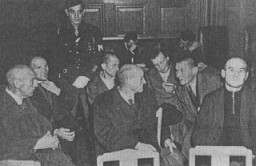
-
J Malan Heslop
Media EssayJ Malan Heslop was a photographer in the US Army Signal Corps. After the camps were liberated, the Signal Corps had a key role in documenting the atrocities of the Holocaust. Heslop captured the plight of survivors in the Ebensee subcamp of Mauthaus...
-
Aron in Howard's men's clothing store
PhotoAron standing in Howard's men's clothing store (named for his eldest son) at 9125 Commercial Avenue in Chicago. He opened the store in 1949 and owned it for 30 years. Chicago, Illinois, early 1970s.

-
Aron standing in Howard's men's clothing store
PhotoAron standing in Howard's men's clothing store (named for his eldest son) at 9125 Commercial Avenue in Chicago. He opened the store in 1949 and owned it for 30 years. Chicago, Illinois, early 1970s.
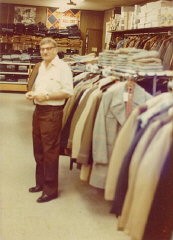
-
Aron in Teaneck, New Jersey, in the early 1970s
PhotoAron in Teaneck, New Jersey, in the early 1970s. This photograph was taken by Hyman Alpert, known as "Trigger." Alpert, a cousin of Aron's, was a musician with the Glenn Miller Orchestra. Alpert went on to become a photographer in Teaneck.

-
Liberation of Nazi Camps: Encountering and Documenting Atrocities
SeriesAs Allied troops moved across Europe against Nazi Germany in 1944 and 1945, they encountered concentration camps, mass graves, and other sites of Nazi crimes. Learn more
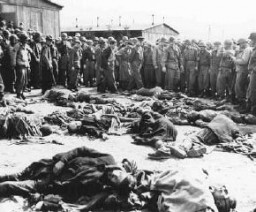
-
Kindertransport, 1938–40
ArticleKindertransport refers to a series of rescue efforts between 1938 and 1940 that brought thousands of refugee children to Great Britain from Nazi Germany.

-
Insignia of the 80th Infantry Division
PhotoInsignia of the 80th Infantry Division. The nickname of the 80th Infantry Division, the "Blue Ridge" division, reflects the home states of the majority of soldiers who formed the division during World War I: Pennsylvania, West Virginia, and Virginia. The Blue Ridge Mountains run through these three states.
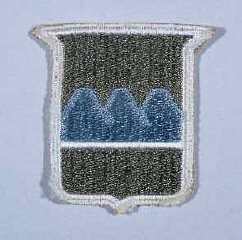
-
The Rhine Crossings in World War II
ArticleCrossing the Rhine River allowed US and British troops to advance into the interior of Germany, helping to bring about the defeat of the Third Reich in WWII
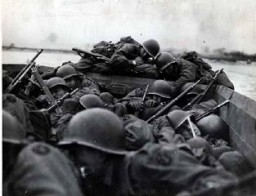
-
Sign hung in storefront of a Japanese American family's business
PhotoTatsuro Matsuda, whose family owned the Wanto Co. grocery store, hung this sign in front of the store, Oakland, California, March 1942. The store was closed following orders for the evacuation of Americans of Japanese ancestry. Evacuees were forcibly deported to relocation centers.

-
Capture of the Bridge at Remagen
ArticleCapturing the Ludendorff Bridge at Remagen was a major milestone for US forces in WWII, allowing the Allies to move troops and tanks across the Rhine river. Learn more.
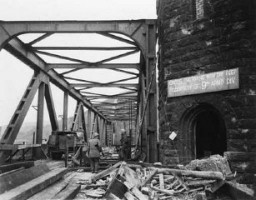
-
2nd Canadian Division
ArticleThe Canadian 2nd Division reached the Westerbork camp on April 12, 1945. Learn about its role in WWII military campaigns and in the liberation of the camp.
